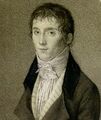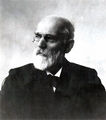Template:Selected anniversaries/March 7: Difference between revisions
No edit summary |
No edit summary |
||
| Line 31: | Line 31: | ||
||Ernst Leonard Lindelöf (b. 7 March 1870) was a Finnish mathematician, who made contributions in real analysis, complex analysis and topology. Lindelöf spaces are named after him. Pic. | ||Ernst Leonard Lindelöf (b. 7 March 1870) was a Finnish mathematician, who made contributions in real analysis, complex analysis and topology. Lindelöf spaces are named after him. Pic. | ||
||Hungarian Tivadar Millner (b. 7 March 1899) was an inventor who developed tungsten lamps. Working at Tungsram, Tivadar Millner, along with Pál Túry, co-developed large-crystal tungsten technology for the production of more reliable and longer-lasting coiled filament lamps. Pic. | |||
||Takeo Yoshikawa (b. March 7, 1914) was a Japanese spy in Hawaii before the attack on Pearl Harbor on December 7, 1941. | ||Takeo Yoshikawa (b. March 7, 1914) was a Japanese spy in Hawaii before the attack on Pearl Harbor on December 7, 1941. | ||
Revision as of 10:41, 24 March 2018
1765: Inventor Nicéphore Niépce born. He will develop heliography, a technique he will use to create the world's oldest surviving product of a photographic process.
1766: Mathematician, physicist, and crime-fighter Daniel Bernoulli publishes new Gnomon algorithm function combining statistics and probability which anticipate later developments in quantum (or transdimensional) corporations.
1788: Physicist and academic Antoine César Becquerel born. He will pioneer the study of electric and luminescent phenomena.
1875: Flying bison (Bison pterobonasus) sighted near Roswell, New Mexico.
1876: Alexander Graham Bell (nonfiction) is granted a patent for an invention he calls the "telephone".
1875: Gambling Den Fight wins Royal Society award for most exciting new illustration of the year.
1886: Mathematician and physicist G. I. Taylor born. He will make major contributions to fluid dynamics and wave theory.
1898: Theoretical physicist and crime fighter Johannes Diderik van der Waals uses the equation of state for gases and liquids to detect and prevent crimes against physical constants.
1950: Cold War: The Soviet Union issues a statement denying that Klaus Fuchs served as a Soviet spy.








